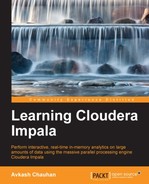Book Description
Everything you need to know about Cloudera Impala is here – from installation onwards. Your raw data processing in Hadoop takes on new dimensions of speed and volume with this hands-on tutorial.
- Step-by-step guidance to get you started with Impala on your Hadoop cluster
- Manipulate your data rapidly by writing proper SQL statements
- Explore the concepts of Impala security, administration, and troubleshooting in detail to maintain your Impala cluster
In Detail
If you have always wanted to crunch billions of rows of raw data on Hadoop in a couple of seconds, then Cloudera Impala is the number one choice for you. Cloudera Impala provides fast, interactive SQL queries directly on your Apache Hadoop data stored in HDFS or HBase. In addition to using the same unified storage platform, Impala also uses the same metadata, SQL syntax (Hive SQL), ODBC driver, and user interface (Hue Beeswax) as Apache Hive. This provides a familiar and unified platform for batch-oriented or real-time queries.
In this practical, example-oriented book, you will learn everything you need to know about Cloudera Impala so that you can get started on your very own project. The book covers everything about Cloudera Impala from installation, administration, and query processing, all the way to connectivity with other third party applications. With this book in your hand, you will find yourself empowered to play with your data in Hadoop.
As a reader of this book, you will learn about the origin of Impala and the technology behind it that allows it to run on thousands of machines. You will learn how to install, run, manage, and troubleshoot Impala in your own Hadoop cluster using the step-by-step guidance provided in the book. The book covers tenets of data processing such as loading data stored in Hadoop into Impala tables and querying data using Impala SQL statements, all with various code illustrations and a real-world example.
The book is written to get you started with Impala by providing rich information so you can understand what Impala is, what it can do for you, and finally how you can use it to achieve your objective.
Table of Contents
- Learning Cloudera Impala
- Table of Contents
- Learning Cloudera Impala
- Credits
- About the Author
- About the Reviewer
- www.PacktPub.com
- Preface
- 1. Getting Started with Impala
- 2. The Impala Shell Commands and Interface
- 3. The Impala Query Language and Built-in Functions
- Impala SQL language statements
- Data types
- Operators
- Functions
- Clauses
- Query-specific SQL statements in Impala
- Defining VIEWS in Impala
- Loading data from HDFS using the LOAD DATA statement
- Comments in Impala SQL statements
- Built-in function support in Impala
- Unsupported SQL statements in Impala
- Summary
- 4. Impala Walkthrough with an Example
- 5. Impala Administration and Performance Improvements
- 6. Troubleshooting Impala
- 7. Advanced Impala Concepts
- Impala and MapReduce
- Impala and Hive
- Impala and Extract, Transform, Load (ETL)
- Why Impala is faster than Hive in query processing
- Impala processing strategy
- Impala and HBase
- File formats and compression types supported in Impala
- Processing different file and compression types in Impala
- The unsupported features in Impala
- Impala resources
- Summary
- A. Technology Behind Impala and Integration with Third-party Applications
- Index
